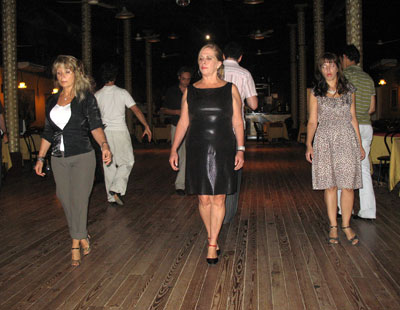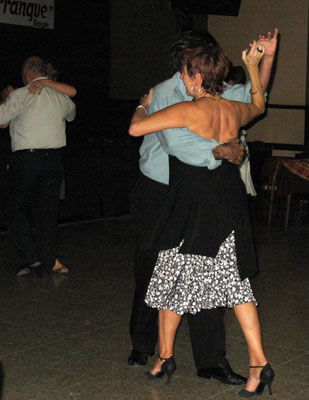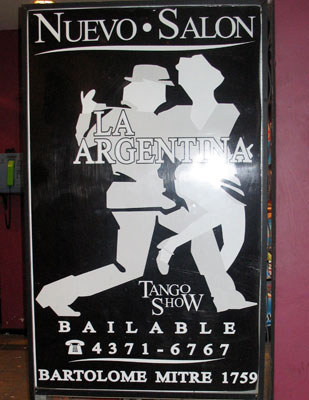Touring for tango in Buenos Aires
by M. Lewis Stein, Irvine, CA
It takes two to tango, but to delve deeper into the tango scene in Buenos Aires, where the dance almost defines the city, we would need the help of three more.
What I sought during a 4-day, January ’09 stay in the city were not the standard tango shows for tourists, which I had seen in the States and on a previous trip to Buenos Aires. I wanted to focus on the places where the locals go to dance.
Advice from the locals
My wife, Barbara, and I got tips on where to go from Francisco Trencheri, the guitarist for the Baja Flor Jazz Trio on the Celebrity Infinity, the cruise ship that had delivered us to Argentina’s capital, where he resides. We also got advice from Alain Houry, the ship’s shore excursion director, a Frenchman who lives in BA. But our third and best source was Roberto Blanc, (Basavilbaso 1263 5-C, C1006AAA Buenos Aires, Argentina; phone 4312 4895), a native porteño (Buenos Aires resident) who was our guide to the city’s tango warrens.
The 60-year-old Roberto, an architect and author who speaks fluent English, not only knows the tango spots (milongas) but is a walking reference source on the town itself — its history, politics and culture — besides being a delightful companion. He charged $50 an hour, which included his hiring of a car and driver. It was worth every penny.
Checking out the scene
Our first stop was La Confitería Ideal (Suipacha 383 – Capital), in the Recoleta district, which had the surreal ambience of an American dance hall in, say, the 1950s.
Singles, both men and women, as well as a few couples sat at tables surrounding a large dance floor supported by thick pillars while others tangoed to recorded music. Most were in their 60s or older and appeared practiced, if not proficient.
Roberto explained that Buenos Aires offered few places for older dancers, thus the popularity of such venues as Ideal. Singles picked out partners, seemingly with an eye for the more skilled ones. One elegantly attired lady, who danced with nearly professional flair, was approached at every dance.
Next we packed off to Club Gricel (La Rioja 1180) in the San Cristóbal district. This place featured a younger crowd — 30s to 60s — and livelier dancers.
The tango has only four basic steps, but how those steps are executed makes all the difference. At Gricel, there was more of an effort to emulate the sensuality that the professionals exhibit. Still, there were apparent novices.
“Notice the ones looking at their feet. They are still learning,” Roberto said.
Gricel is a casual spot, where waiters take time off to dance with patrons.
Admission at milongas, which serve beer, wine, soft drinks and snacks at modest prices, generally runs $2-$6. It’s a cheap night out.
More on milongas
At all our visits we never saw one tourist, American or otherwise. This is not surprising since the locations don’t advertise at hotels and most are tucked away on side streets and behind plain wooden doors.
We usually arrived around 8 p.m., but some milongas don’t open until 11, closing at 3 or 4 a.m.
My favorite of the five halls we visited was El Besco (Riobamba 416), in the Balvanera neighborhood, where the ambience was like that of a charming café, with soft lighting and a smaller dance floor plus a huge tango mural on one wall. The dancers, also a mixed group, were a pleasure to watch — graceful, exciting and surefooted.
“Most have had lessons,” Roberto informed us, “but some of the older ones started so early that they just picked it up.”
For lessons (viewing them, that is), we returned to Club Gricel, where instructors Natalia Games and Gabriel Angio were taking on a new class. The instruction seemed rigorous, with men and women taught separately until the teachers decided they had progressed enough to merit their dancing together.
Overseeing the lessons was semiretired Raul Games, father of Natalie, who had started the school. I asked him how long it took to turn out a tango dancer.
“For some,” he replied, “two months. For others, 20 years.”
Tango schools are a flourishing business in Buenos Aires, along with myriad shops selling dozens of souvenirs with a tango motif — many of them junky, although there are some fine paintings, statuettes and carvings.
Dinner and a show
After visiting two other tango spots, including El Arranque (Bartolomé Mitre 1759), which served great pizza and featured talented dancing, we splurged on a professional tango show, “Carlos Gardel,” recommended by (and booked through) our hotel as the best of the many such spectacles in BA.
The tab was $100 per person, which included round-trip transportation from our hotel to the theater, a 3-course dinner with free-flowing wine, beer and soft drinks and a dazzling performance that brought out the poetic style and sensuousness of tango. It was more theatrical than what I’d seen in the tango road companies in the States, combining dance, storytelling and a bit of comedy, either on a bare stage or with colorful sets.
We stayed at the 4-star Park Chateau Unique (Talcahuano 1253; phone 54 1167770400), which is a bargain at $130 a night, including breakfast, if you can endure its two ancient elevators that stall from time to time because riders neglect to close the doors on exiting.
Our rather plain room did not match the ornate lobby in décor, but it was large and had the usual amenities, including thick towels.
What with tango-hopping, we didn’t have time to dine at the city’s more famous restaurants, but I can recommend Fenicia (Suipacha 1183 – Capital), near our hotel, which combined a tasteful setting with good food at reasonable prices (about $16 for two, with wine).
Tango, anyone?




